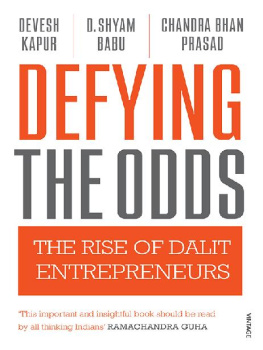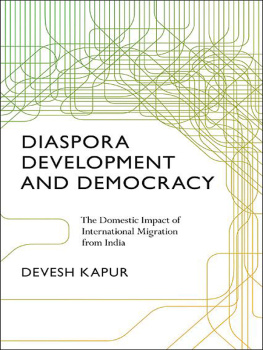Devesh Kapur, D. Shyam Babu & Chandra Bhan Prasad
DEFYING THE ODDS
The Rise of Dalit Entrepreneurs
Contents
Introduction
T he deep social hierarchies of caste have been one of Indias most pernicious historical legacies and continue to hobble the country. No group has borne the deadening burden of this history as much as Dalits.
But while the past informs and shapes the future, it does not dictate it. Socially stratified societies have not exactly been the exception in human history. From slavery to serfdom, feudalism to patriarchy, structures of social power have transformed, some collapsing altogether and others transmogrifying.
The iron grip of the old order was pried open by a range of forcescivil wars, revolutions, legal and constitutional changes, the rise of democracy and universal franchise. But it was also reshaped by technological and economic forces, in particular the industrial revolution and capitalism.
Over the last century, Dalits have sought to escape their predicament through multiple ways, such as religious conversion and linking themselves to anti-Brahmin social movements. They have sought to leverage the promise of universal franchise in the Indian Constitution, supporting political parties professing an egalitarian ethos and even creating their own political parties, first the Republican Party in Maharashtra and more recently, the (bahujan Samajwadi Party (BSP) in Uttar Pradesh. And they have sought mobility through the state itself, through affirmative action programmes in education and public employment.
These combined efforts have surely made a difference and the relative position of Dalits in Indian society is a far cry from what it was at the time of Independence. Nonetheless, while a long road has been travelled, the journey is far, far from complete. Social hierarchies are extremely resilient and weakening them requires overt opposition, multiple pressures and subtle ambushes. However, the old pathways of change, which centred on politics and public action, need to be augmented. If the state itself is decrepit and venal, the likelihood that it will be a resolute defender of the economically weak and socially marginalized in practice (as distinct from rhetoric) is somewhat low. Dalits need additional arrows in their quiver to advance their interests.
It is in this context that this book is situated. One path that the communitys leadership has been wary about is whether marketsand in particular, entrepreneurshipcan be an instrument of social empowerment. In part this is because power and privilege are vested in state organs, which makes accessing organs of the state so critical. In addition, a broad intellectual ethos in India, which looked at markets and entrepreneurship with suspicion, seeing it as an instrument of oppression rather than empowerment, further eliminated this option. With the history of many Dalits as landless labourers, penurious and perennially indebted to moneylenders and landlords, this deep-rooted scepticism was hardly surprising. Business meant traders and moneylenders, occupations with ingrained notions of caste. Hence for Dalits, almost any aspiration was better than becoming a bania !
But India has been changingtoo slowly for some, too unevenly for othersand with it the well-being of Dalits. This is partly the result of a host of legal and constitutional protections, and partly the cumulative consequences of millions of daily struggles as well as the creation of an emerging, albeit small, middle class as a consequence of affirmative action. But it has also been changing as a result of the complex amalgam of forces unleashed by the growth of the Indian economy, the greater role of markets and integration with the global system. Indias actions towards its marginalized communities are under scrutiny not just within the country but also without. New pressures and stress points have erupted along with new fissures and opportunities.
Amidst these unprecedented changes, there has been a remarkable growth of Dalit entrepreneurs, defying the odds as the title of this book declares. Several factors explain this. Firstly, Dalit entrepreneurship has grown because entrepreneurship has grown in India, both because the intellectual climate has changed and also because organized sector employment, be it in the private or the public sectors, has stagnated over the past two decades even as the economy and the population have witnessed massive growth. Net employment in India has been growing mainly in the informal sector, whether in transportation, construction and other service sectors outside agriculture. Hence it is unsurprising that nearly half of Indias labour force is now self-employed. With nearly two million Dalits entering the labour force annually, and public sector employment stagnant, the need for a new paradigm of social justice is manifest. The experiences of the entrepreneurs in this book make clear that while markets may not transcend caste, they mitigate its social salience, while the experience with reservations have only increased its political salience.
It is in this context that entrepreneurship offers new possibilities. The stories in this book are a small slice of a thousand medium and large Dalit entrepreneurs that we have identified and surveyed in collaboration with the Dalit Indian Chamber of Commerce and Industry. It is heartening to note that their combined turnover is in the region of a billion US dollars. But they are not representative in any formal statistical sense either of the Dalit community or even of Dalit entrepreneurs. Finding even these thousand Dalit entrepreneurs was a major task, as there are no official records or data on their existence. Curiously, most Dalit entrepreneurs we surveyed said they were never approached by enumerators of the Economic Census, the only official instrument that supposedly gathers information on entrepreneurs in India comprehensively.
There is, of course, no guarantee that these entrepreneurs will continue to grow, let alone become business tycoons. Nonetheless they are a microcosm of large historical changes that are underfoot in India where a dehumanizing social system is slowly but surely giving way. These changes might appear glacial on a day-to-day basis, but we believe they are epochal. Historians are likely to look back and compare the sheer magnitude of these changes to the century plus of struggles for racial equality in the United States, the decline of serfdom and feudalism in Europe and Latin America and the ongoing struggles for gender equality.
Who are these entrepreneurs? What do they do? What were their pathways to success? In which sectors are they more likely to find success? The entrepreneurs are in a wide variety of sectors, from manufacturing to construction to newly emerging services like healthcare and education. They come from across India but their presence in eastern India is decidedly weaker. Is Dalit entrepreneurship more likely to thrive in states with a more favourable environment for entrepreneurship (as in west and south India) or in states where Dalits are more politically empoweredas has been the case in Uttar Pradeshbut which are not economically dynamic? The answer seems more the former than the latter. A thriving economy may not benefit everyone, but a weak economy does seem to hurt everyone, as is evident by the virtual absence of large Dalit entrepreneurs in Bihar and West Bengal.
There are, regrettably, few women entrepreneurs, an illustration of the continued deep gender inequalities in Indian society, including within Dalit communities.
As one reads the stories in this book, some commonalities emerge in the routes to success for these Dalits. Often, their success was nurtured by one or both parents (and especially the mother) who saw the benefit of providing their child with an education. They ensured funds for the childs education by taking on extra backbreaking work that provided the ready cash, sometimes choosing between their children when finances were severely strained and allowed the education of only one child. Often the siblings would also make sacrifices by taking less so that the pooled resources would be above a minimum threshold. This allowed a chosen child to access opportunities that would create a pathway to success for one member, who in time would hopefully pull up the entire family.














